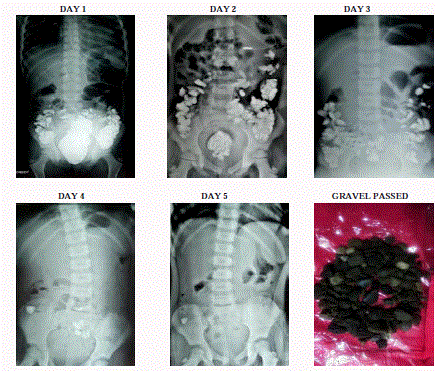Case Report
Over One Kilogram Gravel Ingestion in a Six Year Old Child Managed Conservatively: A Case Report
Babu Lal Sunkaria1, Hitesh Bhatia1*, Priya Bharati2, Navjot Kaur1, Rajandeep Khera1 and Amandeep Singh1
1Department of Surgery, Government Medical College, India
2Department of Medicine, Government Medical College, India
*Corresponding author: Hitesh Bhatia, Department of Surgery, Government Medical College, House NO. 64, Kabir Park, Amritsar-143001, Amritsar, Punjab, India
Published: 19 Jun, 2017
Cite this article as: Sunkaria BL, Bhatia H, Bharati P,
Kaur N, Khera R, Singh A. Over One
Kilogram Gravel Ingestion in a Six Year
Old Child Managed Conservatively: A
Case Report. Ann Clin Case Rep. 2017;
2: 1380.
Abstract
The ingestion of foreign bodies remains a common occurrence in children. We are reporting a case of a six year old girl presented to us with complaints of pain abdomen for one day. On digital rectal examination multiple gravel particles mixed with stools were felt which were removed. The total number of gravel particles excreted were more than 200, weighing around 1300 grams with largest stone passed being 2.7 cm ×1.8 cm in size. The child was managed conservatively with daily stool examination and serial abdominal x-rays.
Keywords: 1.3 gm gravel ingestion; Managed conservatively
Introduction
The ingestion of foreign bodies remains a common occurrence in children. Most ingested foreign bodies pass spontaneously, although up to 1% will result in intestinal perforation [1]. We report a case of six year old child who ingested more than 200 pieces of gravel.
Case Presentation
A six year old girl presented to us with complaints of pain abdomen for one day. Examination
was largely unremarkable with mild tenderness in lower abdomen. On digital rectal examination
multiple gravel particles mixed with stools were felt which were removed.
Keeping in view the possibility of more gravel particles leading to intestinal trauma or impending
obstruction, child was kept nil orally. And put on parentral fluids, antibiotics, analgesics and with
nasogastric tube insertion. X-Ray abdomen showed multiple radio-opaque shadows scattered
throughout the large gut extending from caecum to sigmoid colon and rectum was also studded
with similar shadows.
The child was managed conservatively with daily stool examination and serial abdominal x-rays.
The child kept passing gravels in stools, which progressively decreased in number and by the sixth
day the stools were free from gravel particles. The serial abdominal x-rays confirmed the clearance
of the gut from the gravel. The total numbers of gravel particles excreted were more than 200, weighing around 1300 grams with largest stone passed being 2.7 cm × 1.8 cm in
size. The child was discharged in a satisfactory condition and throughout the stay in the hospital the
child remained asymptomatic.
Figure 1
Discussion
Young children will attempt to swallow wide variety of objects but coins, seeds, pebbles and
part of toys are particularly common. It may be an event witnessed by parents. It usually occurs
accidentally but can result from deliberate ingestion. It is not uncommon to see patients with
recurrent foreign body (FB) ingestion especially mentally challenged children and patients with
psychiatric disorders. Children are commonly brought to medical attention after their caregivers
witness the child swallowing a foreign body or suspect the ingestion due to the disappearance
of an item. Most children are asymptomatic at the time of presentation. Common symptoms
include drooling, gagging, dysphagia, odynophagia, decreased appetite, food refusal, fever, nausea,
vomiting, hematemesis, rectal bleeding, neck pain, chest pain, abdominal pain, halitosis, cough,
stridor, wheezing, and respiratory distress. The majority of ingested FBs that reach the stomach
pass uneventfully through the gastrointestinal tract and the overall risk of perforation is 1% [2].
Endoscopic removal is needed in 10% to 20% cases and in about 1%
of the cases surgical intervention is required, depending upon the
nature, shape, size, number and location of the FBs [2,3]. For most of
foreign bodies, the treatment is conservative, allowing safe passage of
these objects through the intestinal tract. A plain radiograph of chest
and abdomen in case of radiopaque foreign body is quite useful in
guiding the transit of foreign body in GIT.
Conclusion
In conclusion, ingestion of foreign bodies rarely causes perforation of bowel and most of these will pass spontaneously or it may migrate silently to other parts of the body. Surgical intervention should be offered to patient only after trial of conservative management and if the foreign body causes any symptoms of gastrointestinal obstruction or perforation.
References
- Cross KM, Holland AJ. Gravel gut: small bowel perforation due to a blunt ingested foreign body. Pediatr Emerg Care. 2007; 23: 106-108.
- Webb WA. Management of the foreign bodies of the upper gastrointestinal tract update. Gastrointest Endosc. 1995; 41: 39-51.
- Chang JJ, Yen CL. Endoscopic retrieval of multiple fragmented gastric bamboo chopsticks by using a flexible overtube. World J Gastroenterol. 2004; 10: 769-770.

